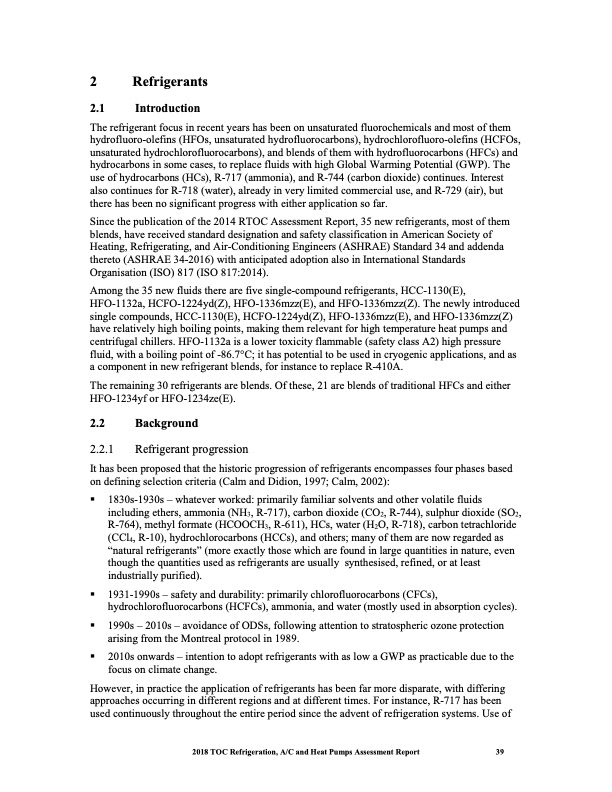
PDF Publication Title:
Text from PDF Page: 052
2 Refrigerants 2.1 Introduction The refrigerant focus in recent years has been on unsaturated fluorochemicals and most of them hydrofluoro-olefins (HFOs, unsaturated hydrofluorocarbons), hydrochlorofluoro-olefins (HCFOs, unsaturated hydrochlorofluorocarbons), and blends of them with hydrofluorocarbons (HFCs) and hydrocarbons in some cases, to replace fluids with high Global Warming Potential (GWP). The use of hydrocarbons (HCs), R-717 (ammonia), and R-744 (carbon dioxide) continues. Interest also continues for R-718 (water), already in very limited commercial use, and R-729 (air), but there has been no significant progress with either application so far. Since the publication of the 2014 RTOC Assessment Report, 35 new refrigerants, most of them blends, have received standard designation and safety classification in American Society of Heating, Refrigerating, and Air-Conditioning Engineers (ASHRAE) Standard 34 and addenda thereto (ASHRAE 34-2016) with anticipated adoption also in International Standards Organisation (ISO) 817 (ISO 817:2014). Among the 35 new fluids there are five single-compound refrigerants, HCC-1130(E), HFO-1132a, HCFO-1224yd(Z), HFO-1336mzz(E), and HFO-1336mzz(Z). The newly introduced single compounds, HCC-1130(E), HCFO-1224yd(Z), HFO-1336mzz(E), and HFO-1336mzz(Z) have relatively high boiling points, making them relevant for high temperature heat pumps and centrifugal chillers. HFO-1132a is a lower toxicity flammable (safety class A2) high pressure fluid, with a boiling point of -86.7°C; it has potential to be used in cryogenic applications, and as a component in new refrigerant blends, for instance to replace R-410A. The remaining 30 refrigerants are blends. Of these, 21 are blends of traditional HFCs and either HFO-1234yf or HFO-1234ze(E). 2.2 Background 2.2.1 Refrigerant progression It has been proposed that the historic progression of refrigerants encompasses four phases based on defining selection criteria (Calm and Didion, 1997; Calm, 2002): 1830s-1930s – whatever worked: primarily familiar solvents and other volatile fluids including ethers, ammonia (NH3, R-717), carbon dioxide (CO2, R-744), sulphur dioxide (SO2, R-764), methyl formate (HCOOCH3, R-611), HCs, water (H2O, R-718), carbon tetrachloride (CCl4, R-10), hydrochlorocarbons (HCCs), and others; many of them are now regarded as “natural refrigerants” (more exactly those which are found in large quantities in nature, even though the quantities used as refrigerants are usually synthesised, refined, or at least industrially purified). 1931-1990s – safety and durability: primarily chlorofluorocarbons (CFCs), hydrochlorofluorocarbons (HCFCs), ammonia, and water (mostly used in absorption cycles). 1990s – 2010s – avoidance of ODSs, following attention to stratospheric ozone protection arising from the Montreal protocol in 1989. 2010s onwards – intention to adopt refrigerants with as low a GWP as practicable due to the focus on climate change. However, in practice the application of refrigerants has been far more disparate, with differing approaches occurring in different regions and at different times. For instance, R-717 has been used continuously throughout the entire period since the advent of refrigeration systems. Use of 2018 TOC Refrigeration, A/C and Heat Pumps Assessment Report 39PDF Image | Heat Pumps Technical Options

PDF Search Title:
Heat Pumps Technical OptionsOriginal File Name Searched:
RTOC-assessment-report-2018_0.pdfDIY PDF Search: Google It | Yahoo | Bing
CO2 Organic Rankine Cycle Experimenter Platform The supercritical CO2 phase change system is both a heat pump and organic rankine cycle which can be used for those purposes and as a supercritical extractor for advanced subcritical and supercritical extraction technology. Uses include producing nanoparticles, precious metal CO2 extraction, lithium battery recycling, and other applications... More Info
Heat Pumps CO2 ORC Heat Pump System Platform More Info
| CONTACT TEL: 608-238-6001 Email: greg@infinityturbine.com | RSS | AMP |